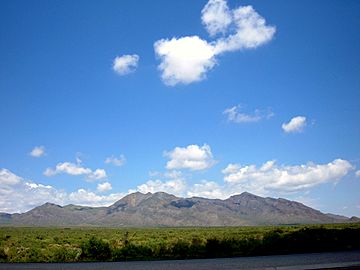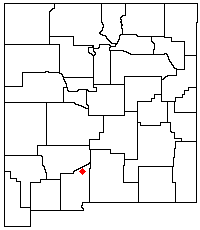San Andres Mountains facts for kids
Quick facts for kids San Andres Mountains |
|
|---|---|

Black and Bennett Mts. on the southeastern end of the San Andres Mountains
|
|
| Highest point | |
| Peak | Salinas Peak |
| Elevation | 8,965 ft (2,733 m) |
| Dimensions | |
| Length | 75 mi (121 km) N-S |
| Width | 12 mi (19 km) W-E |
| Geography | |
| Country | United States |
| State | New Mexico |
| Borders on | Organ Mountains |
| Geology | |
| Type of rock | Limestone |
The San Andres Mountains are a long mountain range in the southwestern New Mexico, a state in the U.S.. These mountains stretch across three counties: Socorro, Sierra, and Doña Ana. The range is about 75 miles (120 km) long from north to south. However, it is only about 12 miles (19 km) wide at its widest point. The very highest spot in the San Andres Mountains is Salinas Peak, which reaches 8,965 feet (2,733 m) into the sky.
Contents
Exploring the San Andres Mountains
The San Andres Mountains are very close to the Organ Mountains in the south. Even though they are neighbors, they are quite different in their rocks and plants. To the north, the Oscura Mountains are separated from the San Andres Mountains by a gap called Mockingbird Gap.
These mountains are quite dry. This means they do not have many large forests. Most of the San Andres Mountains are closed to the public. They are part of the White Sands Missile Range, which is a special area used for important testing. Because of this, people cannot usually visit these mountains.
How the Mountains Were Formed
The San Andres Mountains are part of a large crack in the Earth's surface called the Rio Grande rift valley. These mountains were formed by huge blocks of rock that moved along cracks, or faults. They are mostly made of a type of rock called limestone.
You can also find reddish sandstone on the western side. On the eastern side, there is a rock called quartz monzonite. Over time, water has washed gypsum from these mountains. This gypsum is the main source of the famous white sand dunes found in White Sands National Park.
Some of the important peaks in the San Andres Mountains include:
- Salinas Peak (8,965 feet or 2,733 m)
- San Andres Peak (8,235 feet or 2,510 m)
- Chalk Hills High Point (7,988 feet or 2,435 m)
- Gardner Peak (7,534 feet or 2,296 m)
- Black Brushy Mountain (7,521 feet or 2,292 m)
- Capitol Peak (7,098 feet or 2,163 m)
Desert Bighorn Sheep in the Mountains
The San Andres Mountains are a very important home for Desert bighorn sheep in New Mexico. This area can support up to 400 bighorn sheep. In 1941, a special area of 57,215 acres (231.58 km2) was set aside. This area is called the San Andres National Wildlife Refuge. It was created to help protect the desert bighorn sheep. At that time, there were only 33 sheep.
By the mid-1970s, the number of sheep in the refuge grew to about 200. However, in 1979, a disease caused by tiny mites made many sheep sick. This reduced the population from 200 to just 75. In the years that followed, more sheep were lost to this disease and other problems. By 1997, only one female sheep was left.
To help the bighorn sheep, new sheep were brought to the refuge in 2002. Since then, the herd has grown again. Today, there are about 80 bighorn sheep living in the San Andres Mountains. This shows how important it is to protect these amazing animals.
See also
 In Spanish: Sierra de San Andrés (Nuevo México) para niños
In Spanish: Sierra de San Andrés (Nuevo México) para niños


